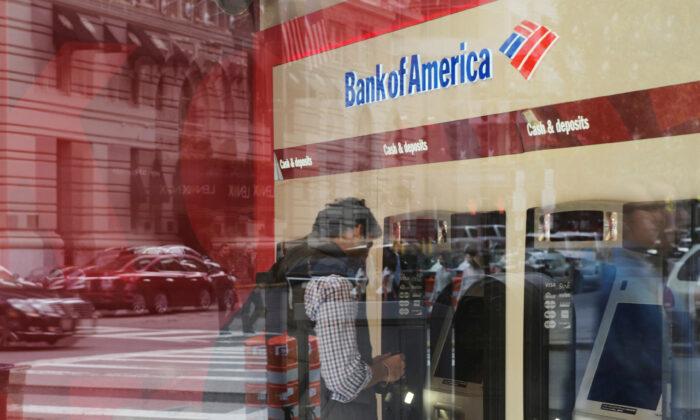BofA said its net interest income (NII) saw its largest boost, surging 25 percent, to $14.4 billion from the year-ago quarter due to the Federal Reserve’s hawkish interest rate policy over the past year. Net interest income is the amount banks earn from lending money, minus what it pays out to customers.
The second-largest U.S. lender expects its NII to fall 2 percent in the second quarter of 2023, compared with the first.
Industry rivals such as JPMorgan Chase and Citigroup have also raked in earnings from higher interest payments in the previous quarter, while setting aside billions of dollars to prepare for an expected recession.
BofA Does Better Than Expected
Meanwhile, BofA revenue increased 13 percent, to $26.3 billion from $23.2 billion, beating earlier Wall Street estimates of $25.13 billion, according to Refinitiv IBES data.Earnings also rose $0.94 per share versus the expected $0.82 per share.
The reported net income increased 15 percent, to $8.2 billion, or $0.94 per diluted share. This is an increase over the $7.1 billion, or $0.80 per diluted share, from the first three months of 2022.
“Every business segment performed well as we grew client relationships and accounts organically and at a strong pace,” Bank of America CEO Brian Moynihan said in a statement.
“Our results demonstrate how our company’s decade-long commitment to responsible growth helped to provide stability in changing economic environments.”
BofA’s reported that its noninterest income increased by just 1 percent, to $11.8 billion, as higher sales and trading revenue offset lower service charges, combined with a decline in asset management and investment banking fees.
“We delivered our seventh straight quarter of operating leverage. We further strengthened our balance sheet and maintained strong liquidity,” Moynihan said.
Sales and trading revenue grew 7 percent, to $5.1 billion in the first quarter.
Credit trading, particularly in mortgages and municipal bonds, also did better, reported CFO Alastair Borthwick.
CEO Moynihan Expects Mild Recession in 2023
Bank of America economists have been warning of a recession for over a year because of high inflation and the Federal Reserve’s aggressive strategy to raise borrowing costs.The BofA CEO predicted that U.S. GDP will see a contraction somewhere in the range of 0.5–1.0 percent in the next three quarters, before returning to positive growth.
“Everything points to a relatively mild recession, given the amount of stimulus that was paid to people and the money they have left over,” Moynihan told analysts during a conference call on April 18.He added that although most consumers remain in good financial health, commercial clients have become more cautious about the economic outlook.
Most economists expect the U.S. economy to slow in the second half of the year, as the Fed continues to raise interest rates to combat inflation.
Revenue at BofA’s consumer unit rose 21 percent, to $10.7 billion in the first three months of the year.
Total consumer spending on debit and credit cards rose 6 percent in the first quarter due to low employment and wage growth, said Borthwick.
“The fact that unemployment is still 3.5 percent [indicates] full employment-plus,” said Moynihan, adding “and then the wage growth is slowing and tipping over. So the signs of inflation are tipping down, and it’s still there, but that translates into relatively good activity.”“We see a slight recession, and we’ll see what happens,” said Moynihan, but he cited low unemployment and easing wage pressures as evidence the downturn will not be severe.
Last week, the central bank released documents admitting that policymakers are bracing for a mild recession this year, with a recovery over the subsequent two years, following the collapse of two regional U.S. banks last month.
Bank Sector Undergoing Stress in Wake of Recent Failures
The recent collapse of both Silicon Valley Bank and Signature Bank in early March sparked an industry crisis and heightened fears over the expected recession later this year.
The bank crisis battered financial stocks and prompted panicking depositors to transfer their deposits to larger institutions.
Total deposits at BofA dropped 1 percent, to $1.91 trillion from the fourth quarter, as worried customers dissatisfied with the deposit rates offered by lenders moved their cash into money market funds to earn greater yields.
The lender’s investment banking fees also fell 20 percent, to $1.2 billion in the first quarter.Global mergers and acquisition activity tumbled to its lowest level in more than a decade, caused by rising interest rates, high inflation, and recession fears.
The slowdown dealmaking has weighed on investment banks in recent months, prompting thousands of job cuts in the sector.
Borthwick expects the bank’s total headcount to fall by about 3,000, to 213,000 by the end of the second quarter from 216,000.“We would also expect to see expense reductions coming from headcount reductions through attrition,” he said.
BofA shares fell 0.8 percent, to $30.12 by afternoon trading, erasing earlier gains from the morning.Reuters contributed to this report.





